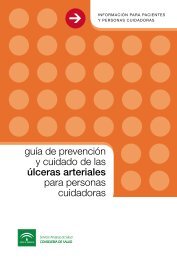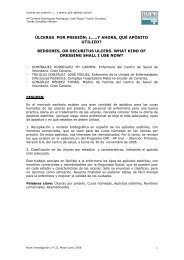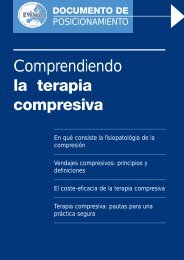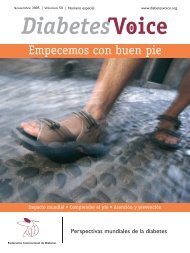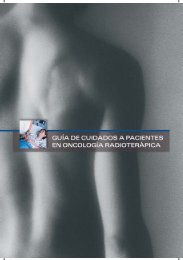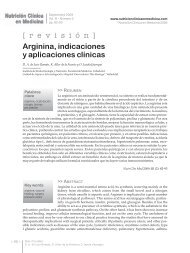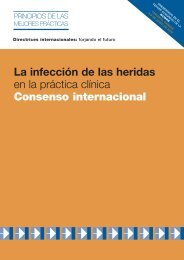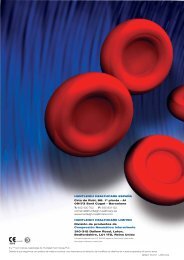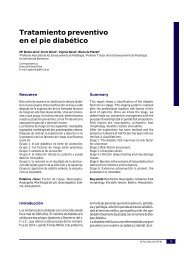Descargar - Úlceras.net
Descargar - Úlceras.net
Descargar - Úlceras.net
- No tags were found...
You also want an ePaper? Increase the reach of your titles
YUMPU automatically turns print PDFs into web optimized ePapers that Google loves.
90 ■ PIE DIABÉTICOCOMBINED ENDOVASCOLARAPPROACHThe optimal management of CLI patientswith multilevel diseases often requires a combinationof endovascular and opens surgicaltechniques (51).The combined approach can be used toincrease the availability of both inflow andoutflow vessels.Interesting results have been obtained onthe run in vessels, with a patency rate from 58to 100%, contrary to run off vessels, asreported by Dougherty et al. (52).Late graft occlusions were attributable tofailure of the endovascular procedure, theproblems being the intrinsic patency ofendovascularly treated lesions.An appropriate follow-up protocol with aprompt reintervention whenever feasible wasnecessary.ACTUAL INDICATIONS FOR BYPASSGRAFTING IN THE ENDOVASCULARERAPTA is frequently used as first choice due torelated low morbidity and mortality rates, reservingOS for failures.Technological advances and maturation ofendovascular skills have allowed percutaneoustreatment of SFA occlusive disease to flourish,and many lesions previously felt amenable onlyto open surgical bypass may now be success -fully managed percutaneously.In this era of increased utilization of endovascularprocedures, the TASC II consensusstill recommends surgical bypass in complexand extensive femoro-popliteal arterial disease.TASC group provided guidelines on the basisonly of morphological indications. The clinicalfeatures have not been considered, even ifdifferent results in terms of patency, overallsurvival, and limb salvage have been reportedto be influenced by the clinical status of thelimb. Moreover these classifications have notbeen followed in the clinical practice, as EVtreatment has been frequently abused forTASC D patients.CLI patients with rest pain or tissue lossfrequently presented TASC D patterns, withlong occlusion. Such lesions were associatedwith a higher risk of EV failure and worseningof the initial runoff score. Ihnat et al. (53) advisednot to attempt EV treatment in patientswith TASC D lesions, with poor tibial arteryrunoff, or with extensive tissue loss.In patients with advanced CLI after one ormore EV failed procedures the distal arterieswere unsuitable for anastomosis because of recentthrombosis, dissection or lack of run-off.In our Department, for this reason, we reservedsurgical revascularization to patientswith serious tissue loss and long arterial occlusions.Our first indications to the treatment hasbeen stated following the clinical presentationsof the diseases, as TASC D lesions were a contraindicationto EV in case of advanced clinicallesions such as tissue loss and gangrene.On the contrary, in case of rest pain weconsidered EV treatment even for TASC D lesionsat the femoro-popliteal level.Therefore a correct approach to the treatmentof CLI is to look at it from three sides:technical issues of revascularization, footwound healing issues, and comorbidity (54).The BASIL Trial was the only RCT up tonow that compared EV and OS in the treatmentof CLI, and failed to demonstrate the superiorityof one method over the other (55).We believe that the Basil trial has the greatlimit to consider, in the surgical arm, preferentiallythe femoro-popliteal bypass: an operationusually ineffective in advanced CLI patients withtissue loss.Reduced amputation-free survival and increasedall-cause mortality were found in theendovascular treatment group after 2 years.For those patients who survived 2 years,however, the randomization to surgery was associatedwith a significant increase in overallsurvival of about 7 months and a trend towardincreased amputation free survival of about 6months during the subsequent mean follow-upof about 3 years.However, vein performed significantly betterthan prosthetic bypass in terms of amputationfree survival.





